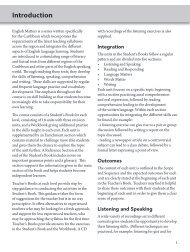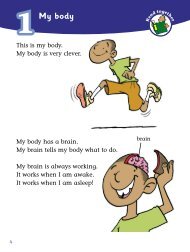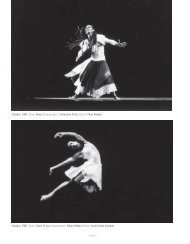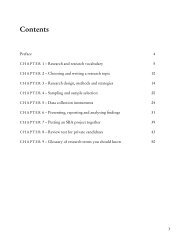Jamaica - Macmillan Caribbean
Jamaica - Macmillan Caribbean
Jamaica - Macmillan Caribbean
Create successful ePaper yourself
Turn your PDF publications into a flip-book with our unique Google optimized e-Paper software.
<strong>Jamaica</strong>in Black and White
ContentsThe camera discovers <strong>Jamaica</strong> Edward Lucie-Smith 6Collecting early <strong>Jamaica</strong>n photographs David Boxer 8The photographers: the Duperlys and their contemporaries David Boxer 10The plate sequencesTextsCataloguing and captionsEdward Lucie-Smith, David BoxerDavid BoxerI Intimations of slavery 22II Sugar – still king 28III Other crops: the fruit of land and sea 38IV Colonial order: Spanish Town and Port Royal 50V Military splendours . . . and a rebellion 64VI Kingston: the photographers’ stamping ground 78VII Kingston: the portrait studios 102VIII Near Kingston: from Ferry to Rockfort, from Constant Spring to Craigton 116IX Other towns 130X Country dwellers, white and black 146XI Railway development 172XII Tourism: a Great Exhibition and new hotels 184XIII Tourist jaunts: picturesque <strong>Jamaica</strong> 196XIV Picturesque otherness: a question of race . . . 230XV Disaster . . . the great Kingston earthquake 254XVI Rebuilding after the disaster: a new Kingston 266Dedication 286Acknowledgements 287List of plates 289
the small cartes de visite that democratisedportraiture all over the world – and the largerimages portraying family groups. The groupportraits are sometimes starkly informativeabout a subject that is still not much discussedin print, though often in private. I mean, ofcourse, miscegenation: these groups sometimesvividly illustrate the intricacy of <strong>Jamaica</strong>n kinshipstructures.Another topic that makes an appearance here isalso closely linked to the subject of race: classdistinction and, to be more specific, the slightlycomic pomp of <strong>Jamaica</strong>’s colonial regime.One cannot, however, claim that the legacy of<strong>Jamaica</strong>n photography covers every possibleaspect of the history and sociology of theisland. Economics enters the equation here –the very poorest did not have the money tobe photographed. When they do appear inphotographs it is often as anonymous units oflabour, rarely as individuals. They are seen asbeing not much different from a coffle of slaves.Where ‘poor’ or disadvantaged individuals areshown, they are portrayed for their supposedlypicturesque qualities. These photographs fitinto a venerable tradition of low-life subjects –one that can be traced back to classical times. Itappears first in Alexandrian Greek and ImperialRoman bronze statuettes of beggars, cripplesand street people, and reappears in full force inthe seventeenth century in Murillo’s paintingsof beggars and in the low-life tavern scenes ofBrouwer and Ostade. It is no surprise to discoverthat some familiar images of <strong>Jamaica</strong>n marketwomen and washerwomen are fictional – theseare not real market women but actresses dressedto look the part.In general, when the <strong>Jamaica</strong>n photography ofthe nineteenth century – and the opening decadesof the twentieth – strays into social criticism,it almost invariably does so by accident. Whilephotography was sometimes harnessed to theabolitionist cause in regions where slaverycontinued to exist, long after its abolition in<strong>Jamaica</strong>, no such focusing issue existed in theisland until the campaign for independence began.Remarkable things about this book, however,are both its relative completeness, and the factthat nearly all the images are drawn from asingle private collection, that of Dr David Boxer,Director Emeritus and Chief Curator of theNational Gallery of <strong>Jamaica</strong>. David Boxer, inaddition to being an immensely experiencedcurator, has remained throughout his careera practising artist, and he has selected hisacquisitions, and compiled the sixteen pictorialsequences presented here, with an artist’s eye. Heis also an impassioned student of the sometimesturbulent history of his country, and has notbeen afraid to venture into areas that some of hiscompatriots may find controversial.Most books of photographs that take <strong>Caribbean</strong>life and environment as their subject are a productof the seduction of local landscape and lifestyle.This applies even to compilations of historicalimages. This one, by contrast, demonstrates thathistoric photographs can be used as a sharp-edgedhistorical tool, to analyse the evolution of whatis now one of the most fascinatingly complexand vibrant societies in the world. Many of thephotographs included here are indeed seductive.Collectively they amount to much more thanthat.Edward Lucie-Smith7
Collecting early <strong>Jamaica</strong>n photographsA. Duperly and Sons, Peep at the Rio Cobre, c.1900. Silvergelatin printBy the early 1860s, with the rise ofphotographic studios like the firm establishedby Adolphe Duperly, the essential work ofour pre-photography artists – landscape andtopographical paintings and of course portraiture– diminished in importance as photographerswere capable of producing photographic versionsthat were not only cheaper but which gave theirpatrons the accuracy of the ‘real’, which was whatthey really wanted.One should not underestimate the hold that thenew medium, photography, had on the public’simagination. It was a miraculous invention;‘a mirror with a memory’ is how one ardentsupporter described the daguerreotype. Thecamera was capable of preserving a piece, amoment, of ‘reality’: no veil of the artist’simagination, no barrier of the artist’s lack ofacademic skills . . . Reality in fact in grisaille, forearly photography’s only drawback as far as thegeneral public was concerned was its inability tocapture colour. In effect photography paralleledthe printmaker’s methodology in the creation ofengravings and lithographs which were all printedin black ink on white paper and then handcoloured,if one could not accept the abstractingeffect of grisaille or black and white.But Great Art transcends reality. So the argumentwent . . . at least in London and Paris, the centresof the key early developments in photography.In <strong>Jamaica</strong>, the average colonial settler or Creoleconsumer of art was hardly in tune with the‘high art’ aspirations of London, Paris and othermetropolitan centres. Our consumers wantedexactly what photography offered: little slicesof the ‘real’; of the facsimile of this person; thisparticular place. And the tourist visitors alsorequired not transcendental ‘art’, but rather theselittle fragments of memory, as souvenirs of thisparticular paradise and of the exotic ‘other’.My first acquisition for this collection was aDuperly print made in the late 1890s. Technically,it astounded me, the beauty of the actual silvergelatin print. They called it a black and whiteprint. But these were purpley plum-blacks ofmyriad tones and creamy whites. How vulgarand inadequate it made those cheap colourisedpostcard reproductions – which is how I hadfirst experienced early <strong>Jamaica</strong>n photography –appear. And its subject? It was called Peep at theRio Cobre, and it transported me to another time,but simultaneously allowed me to re-experiencethat visual and spiritual excitement that I feelevery time I cross Flat Bridge and drive throughthat extraordinary gorge.This colliding of time, the familiar seen throughthe veil of history, is precisely the quality inearly <strong>Jamaica</strong>n photography that made me wantmore and more. These photographs were forthe most part nothing really out of the ordinarytechnically, but they were competent andcompetently ours; and this is what drew me in:it was our history, our reality, our beauty. To putit another way, I connect through memory andlived reality with early images of Kingston or ofCastleton, the streets and paths of which I have8
trod countless times, in a way that I cannot reallyconnect with comparable images of, say, Tokyoor Britain’s Lake District.When I started this collection, virtually nothinghad been written about <strong>Jamaica</strong>n photographyand each work I acquired was able to fill in alittle bit of the history of the medium and itsuse here, but each also offered a window backinto the past and allowed me to relive in a waythat past which had been the present of myparents’ parents and the present of generationsof my ancestors even back to the generations justemancipated from their centuries of bondage.Through these photographs, which I studiedand dated as accurately as possible, I could seein incremental form the deconstruction andreconstruction processes, the evolutionary forcesthat shaped both our landscape and our socialhistory. Indeed, this is the essential story of thecollection presented in this volume, the shapingand reshaping of <strong>Jamaica</strong> in the first seventy-fiveyears that the camera has been a partial witness,which are precisely the years immediatelyfollowing abolition right up to the years of therebuilding of Kingston after the devastatingearthquake of 1907. As I learnt more and moreabout the inheritances of slavery, includingmiscegenation – the mingling of the bloods of theenslaver and the enslaved – I learnt more aboutmyself and more about my country and the socialforces still underway that keep this a society inperpetual change. The photographic history ofthe succeeding seventy-five years, which coverthe lifetimes of my parents and myself, will,hopefully, follow in a second volume.The section of the collection included in thesixteen essayed sequences in this book is madeup of original photographs or photographicallyderived works in a variety of media. There arehardly any early cased images of <strong>Jamaica</strong>n originbut there are in the collection well over 1,500cartes de visite, cabinet cards, albumen and silverprints, photogravures, collotypes, cyanotypes,engravings and lithographs after photographs,stereoviews and lanternslides, to name thevarious media and formats represented. Thiscollection within a collection (the full collectionis not restricted to <strong>Jamaica</strong> nor is it restricted toearly photography) is supported by subsidiarycollections which demonstrate just how someof these photographs were used. Thus there aresubstantial collections of early postcards and ofearly tourist brochures, guide books and pictorialmonographs. Through these collections I havebeen able to construct a history of the mediumand of the practitioners, although it must be saidat the outset that biographical details of mostof the photographers presented in this volume,apart from the major practitioners of the Duperlydynasty, are scant.The collection continues to grow. Early casedimages, such as the daguerreotypes of AdolpheDuperly, are exceedingly rare, and there is aconstant search for these as there is for elusivesubjects – our people ‘at play’ for instance.Where are the early photographic equivalents ofBelisario’s Christmas Amusement series? Indoorphotography was rare in the early days, but still,apart from the occasional river baptism taken byan amateur, where are the images of <strong>Jamaica</strong>nsworshipping? Where too are the ‘Art’ images:studies of nudes, early still lifes? I have but onestill life of fruit from the turn of the century andI have but a single ‘nude’ from this time period, astereoview of adolescent bathers in a river. Theremust be others. And do examples still exist ofthose tantalising subjects that John Savage andthe Duperlys produced in the late 1850s and early1860s: Savage’s original images of a capturedschooner with its cargo of Africans, or theDuperlys’ images of two captured Morant Bayrebels for instance?I continue to search. And as I write this I awaitthe arrival of a small group of prints just won atauction in Britain. They may fill in only minorgaps in the story and expand ever so slightly theiconographic panorama that I am continuallyconstructing, but I will be breathless withexcitement as I open that package, for thoseare small miracles, these time-machines we callphotographs, that lie within.David Boxer9
















